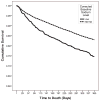Hyponatremia, mineral metabolism, and mortality in incident maintenance hemodialysis patients: a cohort study
- PMID: 23591291
- PMCID: PMC3972035
- DOI: 10.1053/j.ajkd.2013.02.367
Hyponatremia, mineral metabolism, and mortality in incident maintenance hemodialysis patients: a cohort study
Abstract
Background: Hyponatremia is associated with increased mortality in chronic diseases. Recent animal studies also implicate hyponatremia in bone abnormalities. However, associations between hyponatremia, mineral bone abnormalities, and mortality in incident hemodialysis patients are unknown.
Study design: Nonconcurrent prospective cohort study.
Setting & participants: Incident hemodialysis patients from the Accelerated Mortality on Renal Replacement (ArMORR) cohort with available serum sodium measurements from the time of dialysis therapy initiation (n = 6,127) were classified as hyponatremic (sodium, <135 mEq/L) or normonatremic (sodium, 135-145 mEq/L) based on glucose-corrected sodium level at the time of dialysis therapy initiation. Patients with sodium levels >145 mEq/L were excluded (n = 74).
Predictor: Hyponatremia (sodium, <135 mEq/L).
Outcomes: Mineral bone abnormalities; rates of falls, fractures, and mortality.
Measurements: Hyponatremia and mineral bone abnormalities were assessed at the time of hemodialysis therapy initiation. Data for other outcomes were collected during a 1-year follow-up. Univariate and multivariable logistic and Cox proportion hazard analyses were conducted to compute ORs and HRs, respectively, with 95% CIs.
Results: 775 patients were hyponatremic and 5,278 were normonatremic at baseline. In univariate analyses, hyponatremia was associated with hypercalcemia (OR, 1.92; 95% CI, 1.11-3.30), elevated alkaline phosphatase level (OR, 1.36; 95% CI, 1.12-1.66), and hypoparathyroidism (OR, 1.40; 95% CI, 1.18-1.65). Similar relationships were observed in multivariable models. No statistically significant relationships were observed with phosphorus abnormalities, hypovitaminosis D, falls, or fractures. 965 (15.8%) patients had died at the 1-year follow up. Compared with normonatremic patients, hyponatremic patients had higher 1-year mortality in univariate (HR, 1.59; 95% CI, 1.34-1.87) and multivariable analyses (HR, 1.42; 95% CI, 1.19-1.69).
Limitations: Low rate of falls and fractures, lack of data for bone density and fibroblast growth factor 23.
Conclusions: In incident hemodialysis patients, hyponatremia is associated with hypercalcemia, elevated alkaline phosphatase levels, hypoparathyroidism, and increased 1-year mortality. Future studies are needed to examine whether treatments to alter hyponatremia have effects on mineral bone abnormalities and mortality.
Keywords: Sodium; hyponatremia; mineral bone disease; mortality; vitamin D.
Copyright © 2013 National Kidney Foundation, Inc. Published by Elsevier Inc. All rights reserved.
Figures



References
-
- Upadhyay A, Jaber BL, Madias NE. Epidemiology of hyponatremia. Semin Nephrol. 2009;29:227–238. - PubMed
-
- Wald R, Jaber BL, Price LL, Upadhyay A, Madias NE. Impact of hospital-associated hyponatremia on selected outcomes. Arch Intern Med. 2010;170:294–302. - PubMed
-
- Bettari L, Fiuzat M, Shaw LK, et al. Hyponatremia and long-term outcomes in chronic heart failure—an observational study from the Duke Databank for Cardiovascular Diseases. J Card Fail. 2012;18:74–81. - PubMed
-
- Balling L, Schou M, Videbaek L, Hildebrandt P, Wiggers H, Gustafsson F. Prevalence and prognostic significance of hyponatraemia in outpatients with chronic heart failure. Eur J Heart Fail. 2011;13:968–973. - PubMed
Publication types
MeSH terms
Substances
Grants and funding
LinkOut - more resources
Full Text Sources
Other Literature Sources
Medical

